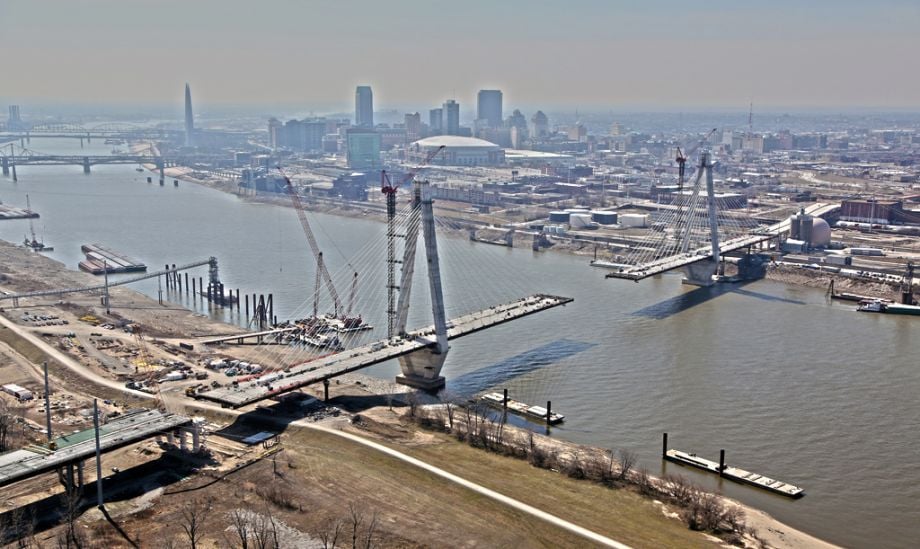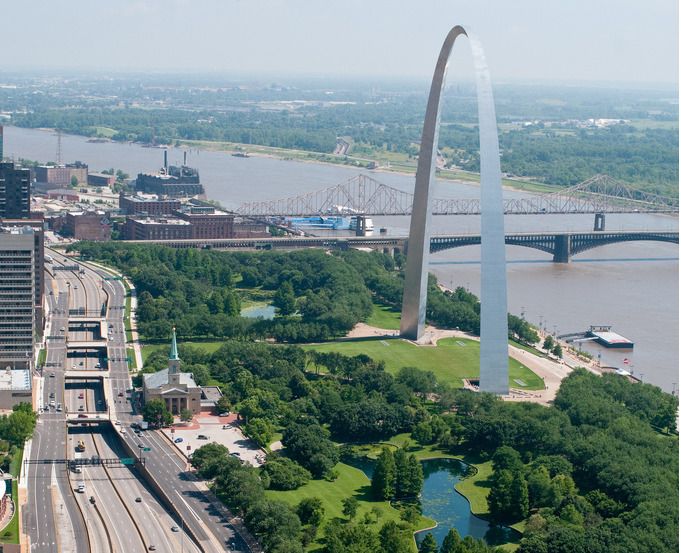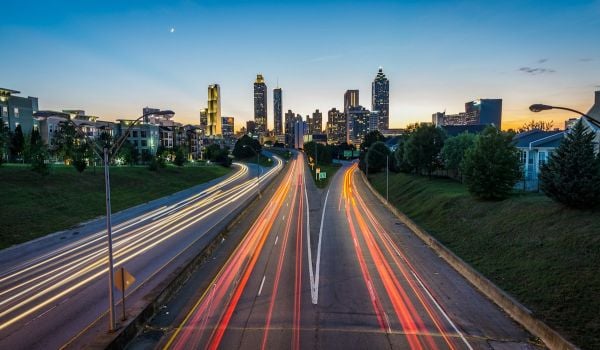St. Louis’ downtown riverfront is on the verge of a transformation. A major new bridge span over the Mississippi River is nearing completion, while on April 2, in separate but simultaneous votes, residents of St. Louis City and St. Louis County approved Proposition P, a 0.1875 percent (3/16th) sales tax increase that will fund a diverse range of regional parks and trails initiatives.
The complicated arrangement is expected to raise between $700 million and $1 billion in new revenue over 20 years, shoring up funding for existing parks and expanding available money for the regional trail building district known as Great Rivers Greenway. Most controversially, it dedicates an unprecedented stream of local revenue to a national park, the Jefferson National Expansion Memorial, home of the Gateway Arch.
Great Rivers Greenway has enjoyed broad support in the St. Louis region since its creation by vote in 2001. Proposition P nearly doubles the agency’s small but steady stream of tax revenue, and will accelerate its progress building a regional network of off-street bike trails. The new money for existing parks will primarily address deferred maintenance and received scant media attention in St. Louis before the vote. But the signature piece, funding JNEM, generated months of discussion, both for breaking new ground in funding federally owned properties and for its efforts to connect downtown St. Louis to the Gateway Arch grounds.
Prior to the vote, National Park Service spokesperson David Barna said that the NPS “cannot find a similar situation” in which a local tax levy was directed at any national park. Lawmakers in Wyoming attempted to set the precedent with a local sales tax to fund Yellowstone National Park infrastructure in 2012, but the bill stalled early in the legislative process.
After false starts during the previous decade, St. Louis political and business leadership coalesced around a plan developed by CityArchRiver 2015, a non-profit lead by longtime political dealmaker and corporate attorney Walter Metcalfe. CAR 2015 launched a design competition and selected the firm Michael Van Valkenburgh Associates as the winner in September 2010. The design reoriented the park entrance axis from the garage on the north to a west to east flow, taking advantage of a new museum entrance and pedestrian cap over the short below-grade section of I-70.
Reaction to the competition winner in the progressive community began favorably but eroded over time as subsequent design iterations, driven less by MVVA and more by the Missouri Department of Transportation, removed existing surface streets in favor of modified highway infrastructure. In December 2012 many younger residents appeared at a Board of Aldermen committee hearing to testify against advancing the tax proposal to the ballot. The excitement at finally connecting downtown to the Gateway Arch was chastened by fear that similar mistakes in access that plagued the park for 50 years were again being made.

Evolution of the Interstate 70 lid. Credit: nextSTL
Before the Gateway Arch was completed in 1967, and before the nation-changing Federal Highway Act of 1956 was passed, St. Louis built the Third Street Highway, widening 2.3 miles of Third Street from two to six lanes and displacing 3,000 residents in the process. The state senator for the area, Anthony Webbe, successfully fended off the project for two years, but by 1951 St. Louis Mayor Joseph Darst had pushed it through.
Only a few years later, in 1963, the Third Street Highway was rechristened I-70 and sunk below grade, forming the “depressed lanes” that separate the downtown commercial district from the National Expansion Memorial, just as the two legs of architect Eero Saarinen’s Gateway Arch were beginning to rise skyward.
The landscape changed little over the next 50 years. The busy, noisy interstate and associated exit ramps made approaching the Arch from downtown unpleasant at best. The most recognizable symbol of St. Louis, a triumph of modern sculpture and the tallest landmark in the U.S., was utterly isolated from the adjacent downtown.
Visions to correct the access problem with a pedestrian bridge over I-70 date back to the original park grounds designed by Saarinen and landscape architect Dan Kiley, but were never built. Saarinen died in 1961, and Kiley’s association with the project ended in 1964 before the Arch was completed.
The CityArchRiver 2015 Foundation’s design is in many ways the culmination of the unfulfilled work of the 1950s and ’60s designs for the Arch Grounds. A central component of the plan is the long sought-after “lid” over the highway, offering direct pedestrian access from downtown to the Gateway Arch. Rebranded the “Park over the Highway” by CAR 2015, the lid will in fact alleviate some of the obvious isolation created by the highway. But for many observers who have followed the project, the result is underwhelming. Much has changed in how we view urban highway infrastructure since the lid was conceived at the dawn of the highway era 60 years ago.
In the intervening years, other cities proved you could remove an urban highway altogether and reconnect a street grid to a waterfront or urban park. The successes are well known: The Embarcadero in San Francisco, Tom McCall Park in Portland, the West Side Highway in New York and the Park Freeway entering downtown Milwaukee. Other projects on the near horizon include two miles of I-10 over Clairborne Avenue in New Orleans and I-81 in Syracuse. As CAR 2015 was ramping up their efforts for the design competition, local advocates for converting I-70 formed the group City to River to increase local awareness of the viability and benefits of a boulevard option.
Grassroots support for removing or converting the highway seemed to be growing. The St. Louis Post-Dispatch had editorialized in favor of removing the highway in early 2010, calling it “A dismal counterpoint to Eero Saarinen’s transcendent symbol of westward migration.” The Congress for the New Urbanism included I-70 on its list of “Freeways Without a Future” in 2010. During a round of public comments to the National Park Service about the CAR 2015 design, an incredible 97 percent of respondents referenced removing I-70. Even the MVVA design submission suggested eliminating the highway would complement their design, declaring, “The benefits of removing the highway altogether are clear.”

A new Mississippi River Bridge reroutes I-70. Credit: MoDOT
Despite public interest, CAR 2015 remained agnostic on removing I-70, saying it was in the province of the Missouri Department of Transportation. For its part, MoDOT made a similar claim, saying there was no reason to pursue a study if it was not part of the CAR 2015 scope of work.
Looming over both decisions is the impending completion of the new bridge over the Mississippi River. In 2014, the bridge will carry I-70 directly across the river north of downtown, bypassing the Gateway Arch grounds completely. With traffic counts expected to drop by up to 50 percent, highway conversion will be more feasible than ever. But in the near future, with tax funding directed at the CAR 2015 improvements and MoDOT not committed the project, it’s an idea with a constituency waiting for both a champion and funding.
Leading up to the April 2 vote, urban-minded St. Louisans were conflicted on the modified MVVA plan and tax proposal. Was the new tax a progressive measure to build first-rate bike infrastructure in the region? Or was it a missed opportunity to solve the vexing divisions created by I-70 50 years ago? While the answer to the first question is a firm yes, the second remains years away from a definitive conclusion.
Scott Ogilvie is a former bike mechanic and graphic designer who now serves on the St. Louis Board of Alderman, representing the city’s 24th Ward.
















